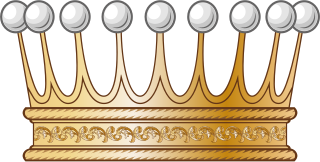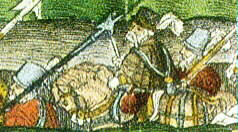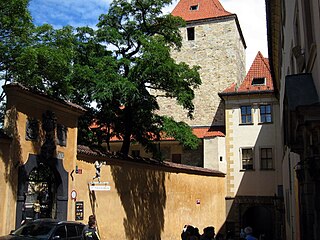
The House of Hohenzollern is a formerly royal German dynasty whose members were variously princes, electors, kings and emperors of Hohenzollern, Brandenburg, Prussia, the German Empire, and Romania. The family came from the area around the town of Hechingen in Swabia during the late 11th century and took their name from Hohenzollern Castle. The first ancestors of the Hohenzollerns were mentioned in 1061.

Hohenzollern-Sigmaringen was a principality in southwestern Germany. Its rulers belonged to the senior Swabian branch of the House of Hohenzollern. The Swabian Hohenzollerns were elevated to princes in 1623. The small sovereign state with the capital city of Sigmaringen was annexed to the Kingdom of Prussia in 1850 following the abdication of its sovereign in the wake of the revolutions of 1848, then became part of the newly created Province of Hohenzollern.

A viscount or viscountess is a title used in certain European countries for a noble of varying status. The status and any domain held by a viscount is a viscountcy.

Graf is a historical title of the German nobility and later also of the Russian nobility, usually translated as "count". Considered to be intermediate among noble ranks, the title is often treated as equivalent to the British title of "earl".
Châtelain was originally the French title for the keeper of a castle.
A castellan, or constable, was the governor of a castle in medieval Europe. Its surrounding territory was referred to as the castellany. The word stems from castellanus. A castellan was almost always male, but could occasionally be female, as when, in 1194, Beatrice of Bourbourg inherited her father's castellany of Bourbourg upon the death of her brother, Roger. Similarly, Agnes became the castellan of Harlech Castle upon the death of her husband John de Bonvillars in 1287. The title of "governor" is retained in the English prison system, as a remnant of the medieval idea of the castellan as head of the local prison.

The Margravate or Margraviate of Meissen was a medieval principality in the area of the modern German state of Saxony. It originally was a frontier march of the Holy Roman Empire, created out of the vast Marca Geronis in 965. Under the rule of the Wettin dynasty, the margravate finally merged with the former Duchy of Saxe-Wittenberg into the Saxon Electorate by 1423.
Frederick V of Nuremberg was a Burgrave (Burggraf) of Nuremberg, of the House of Hohenzollern.

The Burgraviate of Nuremberg was a state of the Holy Roman Empire from the early 12th to the late 15th centuries. As a burgraviate, it was a county seated in the town of Nuremberg; almost two centuries passed before the burgraviate lost power over the city, which became independent from 1219. Eventually, the burgraviate was partitioned to form Brandenburg-Ansbach and Brandenburg-Bayreuth.

Czchów is a town in Brzesko County, Lesser Poland Voivodeship, Poland, with 2,288 inhabitants as of December 2021. It lies on the Dunajec river, and along National Road Nr. 75. In the years 1928-2000, Czchów was a village.

Sommeregg is a medieval castle near Seeboden in the Austrian state of Carinthia, Austria. It is situated in the foothills of the Nock Mountains at an altitude of 749 m.
The Dohna Feud was a 14th-century dispute between the burgraves of Dohna, who resided in the Eastern Ore Mountains of Central Europe, on the one hand and Saxon nobleman, John of Körbitz and the Meißen Margrave William I on the other. The feud lasted from 1385 to 1402.

Henry IV of Plauen, was High Chancellor of the Kingdom of Bohemia, Burgrave of Meissen, Lord of Plauen, Gera, Greiz, Schleiz and Bad Lobenstein, Lord of Toužim, Hartenštejn Castle, Andělská Hora Castle and Žlutice. He also used the traditional title of Lord of Lázně Kynžvart and, apart from an intermezzo in 1547, he was Lord of Bečov nad Teplou as well.
Henry VI of Plauen was Burgrave of Meissen, Lord of Plauen and Lord of Schleiz and Lobenstein.

Dohna Castle on the once important medieval trade route from Saxony to Bohemia was the ancestral castle seat of the Burgraves of Dohna. Of the old, once imposing double castle only a few remnants of the walls remain. The ruins of the old castle are located on the hill of Schlossberg near the subsequent suburb of the town of the same name, Dohna, in the district of Sächsische Schweiz-Osterzgebirge in Saxony, Germany.
The Burgvogt was the administrator of a castle in the Holy Roman Empire.

The Burggraf von Rietenburg was a Middle High German lyric poet in the Minnesang tradition. He was probably the younger brother of the Burggraf von Regensburg. All seven of his surviving stanzas are concerned with courtly love.

The Burggraf von Regensburg was a Middle High German lyric poet who wrote Minnelieder. In his four surviving stanzas, love is not yet courtly love. In one, strongly contrary to later courtly convention, the woman serves the man. All his stanzas are preserved in two manuscripts, the 13th-century Kleine Heidelberger Liederhandschrift and the 14th-century Codex Manesse.

The Supreme Burgrave of the Kingdom of Bohemia, originally the Burgrave of Prague or the Burgrave of Prague Castle was the most important land official of the Kingdom of Bohemia. They were the head of the Bohemian Diet and the Bohemian land court, and commander of the Zemská hotovost.













